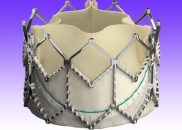We are well aware of the benefits of TAVR in different scenarios, but the need for permanent pacemaker implantation (PPI) in self-expandable valves is between 15% and 30% according to different randomized and non-randomized studies. This is why the higher implantation strategy or cusp overlap (COT) was developed and, though it has been shown to…
High Implantation of Self-Expanding Valves in the Aortic Position or Cusp Overlapping: Should It Be the New “Gold Standard”?
Transcatheter aortic valve replacement (TAVR) has been proving its benefit in different scenarios for two decades now. However, in the field of self-expanding valves, one challenge has always been its high rate of pacemaker implantation compared with balloon-expandable devices and valvular replacement surgery. For this reason, the high implantation or Cusp Overlapping strategy was developed.…
Amyloidosis and TAVR: Does this Disease Have an Impact?
Amyloidosis is a systemic disease that affects different organs and impairs their function. Recent studies with magnetic resonance imaging (MRI) have shown that between 13% and 16% of patients who undergo transcatheter aortic valve replacement (TAVR) have amyloidosis. A review of four studies showed that mortality at 20 months was twice as high when amyloidosis…
When Is It Best to Fracture a Bioprosthesis in TAVR?
At present, surgical aortic valve replacement (SAVR) uses bioprostheses. However, when these fail, we are presented with a great challenge, seeing as repeat SAVR involves a higher risk. In this context, valve-in-valve (V-in-V TAVR) has surged as a very attractive alternative. Bioprosthesis fracture (BPF) is a new interesting strategy that has shown lower gradient and…
TAVR: Vascular Access in Patients with Peripheral Artery Disease, 1-Year Outcomes
At present, the transfemoral access (TFA) is the preferred approach when it comes to transcatheter aortic valve replacement (TAVR). However, 5 to10% of PAD patients present tortuous iliac anatomy and calcification, aortic aneurysms or prior peripheral intervention, which makes it impossible. There are several alternatives to approach these patients: 1) TFA associated to peripheral PCI…
Coronary Physiology after Aortic Valve Intervention
Impact of Aortic Valve Intervention on Coronary Flow Reserve Myocardial flow might be compromised in patients with severe aortic stenosis, which might be driven by CAD and concomitant atherosclerosis or a compromised capillary bed. Capillary circulation might be compromised by increased left ventricular mass (LVM) which in turn might alter coronary flow reserve (CFR). Multiple…
TAVR and New Onset LBBB
The safety and efficacy of transcatheter aortic valve replacement (TAVR) is already established. However, it still poses a challenge for conduction disturbances, such as the need for pacemaker or new onset left bundle branch block (LBBB). The current rate for the latter ranges from approximately 11% to 19%. In most cases, 50% of LBBB reverses…
Valve-in-Valve Shows Good Evolution after 2 Years
The degeneration of bioprostheses in aortic position occurs at approximately after 10 to 15 years. In this scenario, the treatment of choice used to be redo surgery, but with the evolution of transcatheter aortic valve replacement (TAVR), it became a valid alternative with a level IIa B evidence. While there are currently multiple analyses of…
TCT 2022 | FRANCE-TAVI Registry: Small Annuli
The presence of small annuli, defined in this registry as < 23 mm diameter or indexed diameter <12 mm/m2 by CT, continues to be one of the greatest challenges of both surgical and endovascular aortic valve treatments. The FRANCE-TAVI Registry looked at 1,195 patients presenting small annuli. 895 (74.9%) received balloon expandable valves (BEV) and…
Apixaban and Valve Thrombosis after TAVR
TAVR has been associated with early valve thrombosis, characterized by thrombus formation in the prosthetic valve with or without valve dysfunction. This dysfunction is related to leaflet thickening and reduced motion, reduced effective orifice area, or increased transvalvular gradient. A multidetector CT scan allows the dynamic assessment of valves and ruling out fibrosis vs. thrombosis. …









